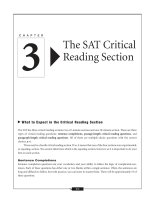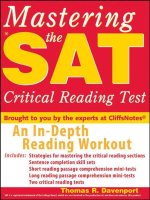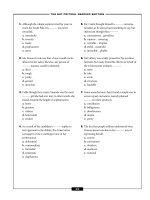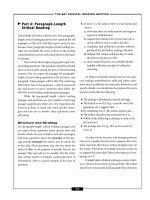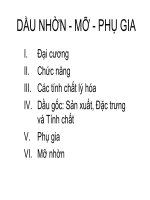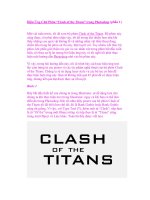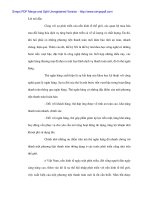The sat critical reading section 1 ppsx
Bạn đang xem bản rút gọn của tài liệu. Xem và tải ngay bản đầy đủ của tài liệu tại đây (93.7 KB, 6 trang )
you may recall, was careful perambulate. Even if you
didn’t know that to perambulate is to walk, or move
about on one’s own, you could be fairly confident that
you had the right answer because careful is such a good
choice.
A Clue for You
The second important skill you must master for sen-
tence completion questions is the ability to identify
key words and phrases. These are the words that most
help you decode the sentence. Think of them as clues
to a mystery. Among the most useful of these are the
words that enable you to identify the logical relation-
ship between the complete unit(s) of the sentence and
the incomplete unit(s). As in the preceding example,
sometimes you have to complete one portion of a two-
blank sentence before you can work on the logical rela-
tionship of another unit. There are three types of logical
relationships commonly expressed in sentence com-
pletion questions: contrast, comparison, and cause and
effect. These three relationships will help you succeed
on sentence completion questions.
Contrast
Words that logically signal a relationship of contrast
are words such as: though, although, however, despite,
but, and yet. Can you think of others? There are also
phrases that signal a contrast between the units of the
sentence, phrases such as on the other hand or on the
contrary. Try making a sentence using these words and
phrases. See how the two parts of your sentence
oppose each other. This is the logical relationship of
contrast, or opposition. No matter how complex a
sentence completion sentence seems at first glance,
when you see one of these words or phrases, you will
know you’re looking at a sentence that expresses one
thought in its complete unit and a contrasting thought
in the incomplete unit. First, you decipher the thought
in the complete unit, and then fill in the blank in the
incomplete unit with a word that expresses a contrast-
ing thought. For example:
Although the tiger is primarily a solitary beast, its
cousin the lion is a animal.
First, divide the sentence into two units, using
the punctuation to guide you. Now you have as the
first unit, Although the tiger is primarily a solitary beast,
and, its cousin the lion is a animal, as the sec-
ond unit. The first unit tells you by the use of the word
although that the second unit will express a relation-
ship of opposition or contrast. You can see that tigers
and lions are being contrasted. The word that goes in
the blank has to be an adjective that describes animal
in the way that solitary describes beast. Therefore, the
word that will contrast with the idea in the first unit is
in opposition to solitary. What is an antonym of soli-
tary? Solitary means alone. You might choose the
word social. Friendly, gregarious, or sociable are other
options, all meaning “not solitary.” Then you look for
the word in the answer choices that is a synonym of
the word you chose.
Comparison
There are two kinds of comparison relationships:
comparison by similarity and comparison by restate-
ment. Words that signal comparison are words such
as likewise, similarly, and and. Phrases that introduce
comparisons are just as, as as, for example, as
shown and as illustrated by. Words and phrases that
precede restatement are namely, in other words, in
fact, and that is. Relationships of logical comparison
are straightforward. The idea expressed in the com-
plete unit of the sentence is similar to or the same as
the idea that needs to be expressed in the incomplete
unit. When you know what the complete unit says,
you know what the incomplete unit needs to say—the
same thing, or very nearly so. Here’s an example of a
comparison sentence:
Until he went to military school, Foster never
stood up straight; as illustrated by his in
this photograph.
–THE SAT CRITICAL READING SECTION–
42
5658 SAT2006[03](fin).qx 11/21/05 6:42 PM Page 42
This sentence has three units, two complete and
one incomplete. The first two units tell you that before
military school, Foster slouched. The blank in the third
unit, therefore, needs to be filled by a word that will
illustrate his slouching. The correct answer will be pos-
ture, or its synonym.
Cause and Effect
A third kind of logical relationship often expressed in
sentence completion questions is the cause and effect
relationship. In other words, the sentence states that
one thing is a result of something else. Again, you can
rely on key words to point you in the right direction.
Words such as thus, therefore, consequently, and because
and phrases such as due to, as a result, and leads to sig-
nal a cause and effect relationship. Try making some
cause and effect sentences to see how they work.
Here’s an example of a cause and effect sentence
from the pretest:
Scientific knowledge is usually , resulting
often from years of hard work by numerous inves-
tigators.
The complete unit of the sentence, resulting often
from years of hard work by numerous investigators, tells
you that the other unit results from numerous investi-
gators working hard for years. The incomplete unit,
the one with the blank, tells you that you are looking for
a word to describe scientific knowledge as a result of
those years of hard work. You know that whatever word
the test-makers are looking for, it must have some-
thing to do with lots of stuff, because years of hard
work by numerous investigators would produce a lot of
something. The answer choice that was correct for that
question, you may remember, was cumulative, which
applies to lots of stuff.
Putting It All Together
Once you learn how to identify the complete and
incomplete units of a sentence, using punctuation to
guide you, you’ve made a good start. Next, determine
the logical relationship of the units, using key words
and phrases; and then you understand what the sen-
tence is saying, even if there’s some vocabulary you
don’t understand. But if you keep working on building
your vocabulary, chances are, you will understand the
most crucial words.
The Big Eight: Steps for
Answering Sentence Completion
Questions
When you break up sentences using punctuation as a
guide, you end up with more or less manageable chunks
of words. Nevertheless, when you have a 25-word sen-
tence, which is not that uncommon on the SAT, and
you break it into two units, you can still easily have a
12–15 word unit. On the real SAT, there have even been
20–30 word sentences with no punctuation except for
the period at the end.
These long sentences are further complicated by
the fact that they often include difficult vocabulary.
Seeing words you don’t know may send your anxiety
level soaring, and nobody does his or her best work
–THE SAT CRITICAL READING SECTION–
Signal Words and Phrases
43
contrast—although, but, despite, however, yet, though
comparison—likewise, just as, similarly, for example, as illustrated by, and, as . . . as
restatement—in other words, namely, that is
cause and effect—as a result, due to, therefore, thus, leads to, because, consequently
5658 SAT2006[03](fin).qx 11/21/05 6:42 PM Page 43
when anxious. With practice, though, you can learn to
take those long sentences and unknown words in stride.
Here’s how to start.
1. Start small. Don’t tackle the whole sentence at
once. There are several techniques for breaking
sentences into smaller units. Using punctuation
to guide you, as demonstrated in the previous
section, is the most obvious method. If the guid-
ing commas and semicolons aren’t there, how-
ever, you will need to look for other places to
break up a sentence. One way you can do this is
to find a verb (an action word that tells you
what’s happening) and gradually incorporate the
words around it into an increasingly longer
phrase as you decipher its meaning. The verb
provides an anchor for the meaning because it
tells you what is being done.
You can also use trial and error to find
islands of meaning in a sentence. Find a word or
a phrase you understand and start adding a word
or two on either side. As you discover several
such islands and gradually enlarge each one, you
will eventually see how they fit together; and
then you will understand the dynamics of the
whole sentence.
2. If the vocabulary in a sentence is a problem, look
at the words around it. Usually, you can figure
out what function a word is serving in the sen-
tence. Ask yourself if it’s an action word. If so, it’s
a verb. Is it describing something? Then it’s an
adjective or adverb. Is it the subject (the person,
place, or thing) performing the action in the sen-
tence? It’s a noun or pronoun. Use the surround-
ing context to help you guess the meaning or at
least the part of speech of an unfamiliar word.
3. As you are reading a sentence with blanks or with
words you don’t know (which might as well be
blanks!), it can ease your anxiety to substitute
words or sounds of your choosing in place of the
unknown words. The words something and what-
ever work well in many situations. You may find
you prefer nonsense words instead, such as yada-
yada or blah-blah. As the meaning of the sentence
gradually becomes clear, you can start substitut-
ing words that might work in the sentence.
4. Now that you have the gist of the sentence, it’s
time to think about filling in the blanks. It is cru-
cial at this point that you do not look at the
answers! Because the SAT has so many distracter
answers that will look right if you haven’t deci-
phered the meaning of the sentence, it would be
a mistake to look at the answers to see what
word(s) might go in the blank(s). You have to
decide first what the answer needs to express.
Then you can look at the answer choices to find
one that matches your idea. It is not important
that you come up with the perfect single word to
express your idea. A phrase is fine, as long as you
are clearly expressing the meaning you think the
correct answer choice will express.
5. As you are deciding on the correct idea for the
blank or blanks to express, be sure you are stick-
ing to what is expressed in the sentence. Don’t let
the idea(s) in the sentence lead you off into
another area. Perhaps the sentence reminds you
of something you’ve read or heard that would
perfectly complement the idea(s) in the sentence.
Your information may be true, but it’s a mistake
to use your outside knowledge in completing a
sentence. Remember, there will often be key
words or phrases signaling the relationship of the
various parts of the sentence. And there will
always be enough information within the sen-
tence so that you can answer without having any
outside knowledge. Stick to the information
within the sentence itself.
6. When you think you know what idea the answer
word needs to express, it’s time to look at the
answers. If you see an answer choice that seems to
match your idea, try plugging the answer into the
sentence to see if it is internally consistent. That
–THE SAT CRITICAL READING SECTION–
44
5658 SAT2006[03](fin).qx 11/21/05 6:42 PM Page 44
means, check to see if it fits into the sentence
without introducing any new ideas. If it seems to
fit but brings in an idea you can’t find anywhere
else in the sentence, it’s the wrong answer.
7. If you can’t settle on an absolutely correct
answer, use the process of elimination to help
you. Once you’ve deciphered the meaning of
the sentence, breaking it apart and fitting it back
together, chances are, you will immediately see
one or two answers that make no sense within
the existing framework of the sentence. Elimi-
nate all answers that don’t fit the meaning of
the sentence.
When you eliminate an answer, draw a line
through it. Cross it out, mark it off, eliminate it
from your consciousness. You no longer need to
consider it, so don’t let it slow down your
thought process by continuing to exist as a
possibility.
Promise yourself, however, that you will
never eliminate an answer choice just because
you don’t know the vocabulary. Never rule out
an answer because you don’t know the meaning
of the word(s). Sometimes, in fact, you will be
able to eliminate all the other answers, leaving
you with the one answer you don’t understand,
but which must be the correct choice.
A final warning about eliminating answers is
that it must always be a conscious choice to elimi-
nate an answer. Many times, distracter answers are
positioned as choice a or b so that you see them,
think hurriedly, “Oh, that’s the one!” and move on
without even looking at the other answers, includ-
ing the correct one. Even if you think you see the
correct answer, look at all the answer choices
before making your final selection.
8. When a question has two blanks, you may be
able to figure out the answer to one blank but not
the other. If so, that’s good—you can now elimi-
nate all answers that do not fit in the blank you
know. Then you can continue your efforts by
focusing exclusively on the other blank.
–THE SAT CRITICAL READING SECTION–
45
5658 SAT2006[03](fin).qx 11/21/05 6:42 PM Page 45
5658 SAT2006[03](fin).qx 11/21/05 6:42 PM Page 46
40 Practice Sentence Completion Questions
In each of the following sentences, one or two words have been omitted (indicated by a blank). Choose the word(s)
from the answer choices provided that make the most sense in the context of the sentence.
Use the answer sheet below to record your answers.
ANSWER SHEET
–LEARNINGEXPRESS ANSWER SHEET–
47
1.abcde
2.abcde
3.abcde
4.abcde
5.abcde
6.abcde
7.abcde
8.abcde
9.abcde
10.abcde
11.abcde
12.abcde
13.abcde
14.abcde
15.abcde
16.abcde
17.abcde
18.abcde
19.abcde
20.abcde
21.abcde
22.abcde
23.abcde
24.abcde
25.abcde
26.abcde
27.abcde
28.abcde
29.abcde
30.abcde
31.abcde
32.abcde
33.abcde
34.abcde
35.abcde
36.abcde
37.abcde
38.abcde
39.abcde
40.abcde
5658 SAT2006[03](fin).qx 11/21/05 6:42 PM Page 47
